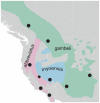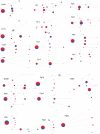Is gene flow promoting the reversal of pleistocene divergence in the Mountain Chickadee (Poecile gambeli)?
- PMID: 23152877
- PMCID: PMC3495768
- DOI: 10.1371/journal.pone.0049218
Is gene flow promoting the reversal of pleistocene divergence in the Mountain Chickadee (Poecile gambeli)?
Abstract
The Pleistocene glacial cycles left a genetic legacy on taxa throughout the world; however, the persistence of genetic lineages that diverged during these cycles is dependent upon levels of gene flow and introgression. The consequences of secondary contact among taxa may reveal new insights into the history of the Pleistocene's genetic legacy. Here, we use phylogeographic methods, using 20 nuclear loci from regional populations, to infer the consequences of secondary contact following divergence in the Mountain Chickadee (Poecile gambeli). Analysis of nuclear data identified two geographically-structured genetic groups, largely concordant with results from a previous mitochondrial DNA (mtDNA) study. Additionally, the estimated multilocus divergence times indicate a Pleistocene divergence, and are highly concordant with mtDNA. The previous mtDNA study showed a paucity of sympatry between clades, while nuclear patterns of gene flow show highly varied patterns between populations. The observed pattern of gene flow, from coalescent-based analyses, indicates southern populations in both clades exhibit little gene flow within or between clades, while northern populations are experiencing higher gene flow within and between clades. If this pattern were to persist, it is possible the historical legacy of Pleistocene divergence may be preserved in the southern populations only, and the northern populations would become a genetically diverse hybrid species.
Conflict of interest statement
Figures






Similar articles
-
The influence of latitude, geographic distance, and habitat discontinuities on genetic variation in a high latitude montane species.Sci Rep. 2018 Aug 7;8(1):11846. doi: 10.1038/s41598-018-29982-7. Sci Rep. 2018. PMID: 30087363 Free PMC article.
-
Phylogeography of the mountain chickadee (Poecile gambeli): diversification, introgression, and expansion in response to Quaternary climate change.Mol Ecol. 2007 Mar;16(5):1055-68. doi: 10.1111/j.1365-294X.2007.03199.x. Mol Ecol. 2007. PMID: 17305860
-
Genetic divergence in the common bush-tanager Chlorospingus ophthalmicus (Aves: Emberizidae) throughout Mexican cloud forests: The role of geography, ecology and Pleistocene climatic fluctuations.Mol Phylogenet Evol. 2016 Jun;99:76-88. doi: 10.1016/j.ympev.2016.03.014. Epub 2016 Mar 14. Mol Phylogenet Evol. 2016. PMID: 26988412
-
When east meets west: population structure of a high-latitude resident species, the boreal chickadee (Poecile hudsonicus).Heredity (Edinb). 2013 Oct;111(4):321-9. doi: 10.1038/hdy.2013.54. Epub 2013 Jun 12. Heredity (Edinb). 2013. PMID: 23759728 Free PMC article.
-
Identifying mechanisms of genetic differentiation among populations in vagile species: historical factors dominate genetic differentiation in seabirds.Biol Rev Camb Philos Soc. 2020 Jun;95(3):625-651. doi: 10.1111/brv.12580. Epub 2020 Feb 5. Biol Rev Camb Philos Soc. 2020. PMID: 32022401 Review.
Cited by
-
The influence of latitude, geographic distance, and habitat discontinuities on genetic variation in a high latitude montane species.Sci Rep. 2018 Aug 7;8(1):11846. doi: 10.1038/s41598-018-29982-7. Sci Rep. 2018. PMID: 30087363 Free PMC article.
-
Contrasting genetic trajectories of endangered and expanding red fox populations in the western U.S.Heredity (Edinb). 2022 Aug;129(2):123-136. doi: 10.1038/s41437-022-00522-4. Epub 2022 Mar 21. Heredity (Edinb). 2022. PMID: 35314789 Free PMC article.
-
Asymmetric allelic introgression across a hybrid zone of the coal tit (Periparus ater) in the central Himalayas.Ecol Evol. 2021 Nov 24;11(23):17332-17351. doi: 10.1002/ece3.8369. eCollection 2021 Dec. Ecol Evol. 2021. PMID: 34938512 Free PMC article.
References
-
- Hewitt GM (1996) Some genetic consequences of ice ages, and their role in divergence and speciation. Biological Journal of the Linnean Society 58: 247–276.
-
- Lynch M, Conery J, Burger R (1995) Mutation accumulation and the extinction of small populations. American Naturalist 146: 489–518.
-
- Bulgarella M, Peters JL, Kopuchian C, Valqui T, Wilson RE, et al. (2012) Multilocus coalescent analysis of haemoglobin differentiation between low- and high-altitude populations of crested ducks (Lophonetta specularioides). Molecular Ecology 21: 350–368. - PubMed
-
- Kearns AM, Joseph L, Omland KE, Cook LG (2011) Testing the effect of transient Plio-Pleistocene barriers in monsoonal Austalo-Papua: did mangrove habitats maintain genetic connectivity in the black butcherbird? Molecular Ecology 20: 5042–5059. - PubMed
Publication types
MeSH terms
Substances
Grants and funding
LinkOut - more resources
Full Text Sources

